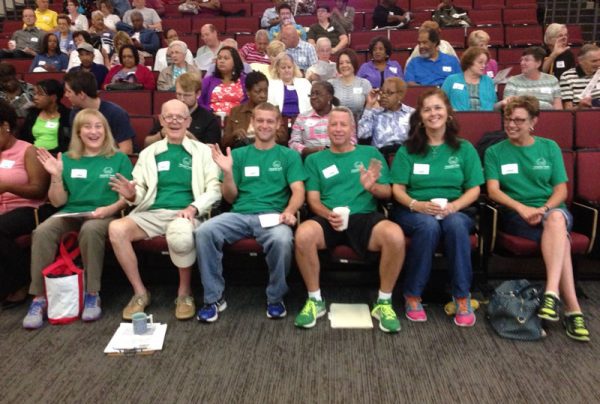A day for neighborhoods to explore their future

If Charlotte is a city of neighborhoods, what happens when almost 20 of those neighborhoods spend a half-day at a retreat to encourage goal-setting? To find out, I spent Saturday morning at the City of Charlotte’s fourth Neighborhood Boards Retreat. Not surprisingly, the neighborhood representatives emerged with a cluster of goals.
Representatives from 18 neighborhoods attended the retreat at the UNC Charlotte Center City campus. The UNC Charlotte Urban Institute co-sponsored the event with the city.
The neighborhoods came from areas as geographically diverse as Steelechase and McDowell Farms in southwest Charlotte to Turtle Rock in far eastern Charlotte to Fox Glen, which straddles I-485 where it’s under construction at the city’s northern edge.
The city’s department of Neighborhood and Business Services, which arranged the event, handed out data sheets tailored to each of the 18 neighborhoods. (Click here to download a look at all the data sheets.) And the morning kicked off with a bit of cheerleading session.
Tom Warshauer, community engagement manager, offered a video that got the crowd laughing, of a lone dancer at a music festival in Washington State, who’s joined after a few minutes by another dancer, and then by a third, at which point other dancers flock to join the dancing crowd. (Click here to see the YouTube video of “Sasquatch music festival 2009 – Guy starts dance party.” ) Neighborhood advocates can often feel like that one, lonely dancer, he said. “It’s the second person that really gives a leader credibility,” Warshauer said.
Then Rebecca Hefner, who works with the city-county Quality of Life Study, gave a brief description of the data sheets, pointing out that the neighborhoods represented Saturday had a lower energy footprint than the city average. “In general,” she said, “you all here are planet-savers.”
I sat in on a couple of neighborhoods’ sessions, listening as facilitators helped them discuss their vision for their areas and their strategies for bringing that vision to life.
Lakewood, for instance, sits northwest of uptown, off Rozzelles Ferry Road. It has not been a prosperous area and has seen the problems that come with lack of affluence. “We need a store!” was how longtime resident and neighborhood association president Nola Murphy put it. But with a neighborhood median income of $27,143, less than half the overall city’s $61,973, and unemployment at almost 30 percent, it’s been a challenge to get retailers interested.
She and Lakewood neighbors Delores Miller and Chini Nichols, with help from facilitator Jason Fararooei, talked about what they’d like to see happen: removal of substandard housing, a neighborhood center, and new signs marking the entrance to Lakewood.
While they were tallying neighborhood assets and setting their vision, I checked in on the Belmont Community Association members who were working through their own plans. They already had a neighborhood vision statement: “To foster a safe, friendly and diverse community through neighbors working together.”
But the tougher work lay ahead. What, specifically, could the neighborhood association do? Wide-ranging discussion ensued: “I’d like to see more of the whites come to our church events,” said longtime neighborhood resident Brenda Erwin, who’s African American and attends St. Paul Baptist Church in the heart of the neighborhood. “Just feel comfortable and come and be a part.”
Amid the nodding and mutters of agreement, someone said, “But we don’t know about them.” Although the neighborhood was 80 percent black in the 2010 Census, more white residents have been moving in, attracted by the area’s historic housing stock and proximity to uptown. (See “Once crime-ridden, old mill villages blossom.”) Indeed, the neighborhood association group that met Saturday had more white attendees than black ones.
But as they all kept talking, they began to focus on how the neighborhood association could better connect with neighborhood residents, especially newcomers. “We have a welcome-to-the neighborhood newsletter,” said Terry Cook. “Well, we have it drafted, anyway … ”
They quickly decided Cook should send the draft to association president Vicki Jones, who could distribute copies to each board member. They decided to use the upcoming National Night Out event in August as a time to invite people to attend BCA meetings, and get names and contact information from more neighborhood residents. One newly adopted goal: Attract at least one new person to attend the next BCA meeting.
Overall, the Belmont group’s goals touched on three categories: Better communication among and by BCA members, building neighborhood trust, and better use of neighborhood and city resources.
A look back at goals from the previous three neighborhood board retreats shows those aims are typical. “Establish outreach to new and existing neighbors,” says one neighborhood’s goal from July 2012. “Meet our neighbors,” says another from that 2012 session. “More volunteers for committees,” says another, from February of this year.
The list of goals from the 18 neighborhoods who gathered Saturday won’t be available for a while, as city staff go through the materials.
But I suspect the real work – whether it’s getting that newsletter draft sent out, or researching who you call at the police department to get some signs lowering speed-limit – has already started.
